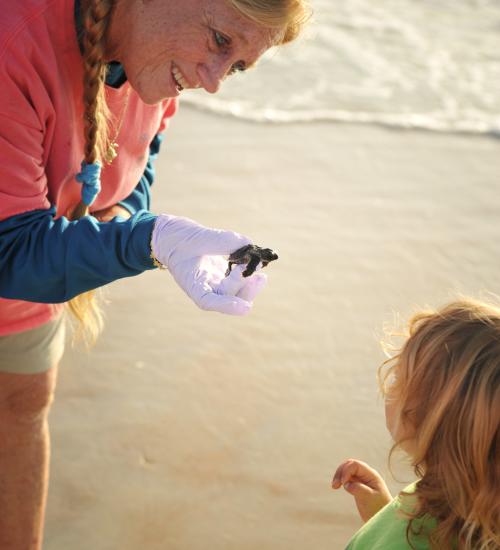Meet Lori Ottlein, a volunteer with the Volusia/Flagler Turtle Patrol. Ottlein has dedicated 23 years to the organization, helping to protect these magnificent sea creatures.
Why did you decide to become a volunteer with the Turtle Patrol?
I wanted to volunteer for something that helped animals and I love turtles and tortoises, so it was a dream come true to be able to help sea turtles survive.
What does a typical day look like when volunteering?
A normal day on patrol starts at first light. So usually at 6 a.m., we get onto the beach and look for new nests in the beginning of the season, which starts May 1st. Then we “mark” the nests with stakes and ribbon to keep it protected from people coming to the beach with umbrellas and beach things. After a nest is laid, mom never comes back, so it is our job to protect the eggs. After approximately 45 to 70 days, the eggs hatch.
We monitor every nest every morning, so we will see what we call an emergence. This is when the hatchlings climb out of the next and crawl to the ocean. We can tell when this happens by the tiny turtle tracks coming out of the next and down the beach to the ocean. We give the hatchlings 3 days to climb out on their own. On the third day, we do a nest evaluation. This is when we dig by hand into the next and count how many eggs hatched and how many didn’t or how many didn’t make it out. The nest is about 58 cm deep, so the hatchlings have a tough start to life. Sometimes we have hatchlings that didn’t make it out of the nest, and we save them and release them to the ocean.
What’s your favorite part of volunteering?
I love the sea turtles and love educating others about them. Lot of people have no idea about them and when they learn about them, they are amazed. I love when people “adopt” a nest. This is a $50 investment, and the money goes to our patrol for supplies and fuel for the ATV. When that adopted nest hatches, they get invited to the “cleaning” and get to sometimes see hatchlings released right there. It is a very exciting time. It’s an awesome “job.”
How can visitors help protect turtles during nesting season? No lights on the beach?
The lights and flashlights on the beach can disorient the moms coming onto the beach to nest and are very harmful to the hatchlings when they come out of the nest. They are, by instinct, attracted to the brightest light that they see. This should be the glow of the moon over the ocean. If there are bright streetlights, flashlights on the beach, or a fire on the beach, they will head straight to that light source. This causes some to come up over the dunes and onto A1A or they can crawl three blocks to the bright light, exhausting themselves. Once they hit the ocean, they will have to swim for miles before being able to rest in the offshore sargassum. Only about 1 hatchling in 1000 will make it to the sargassum. They have so many predators and the odds are just against them.
Plastic bags are a great threat to the turtles. They love to eat jellyfish and a bag in the ocean looks like a delicious meal to them. Once ingested, it will lodge in their stomach and can kill them. Hatchlings have been found with lots of tiny bits of plastic in their stomachs. The best way to help is to clean up when you leave the beach and leave no trash. Take a bag and walk the beach to pick up garbage and save a sea turtle. Very simple!
If you’ve seen it, what does it feel like to watch hatchlings leave their nests?
It is an amazing sight! They come out of the nest in a frenzy. Most hatch at the same time and crawl over each other to break free of the nest.
Can you describe how you spot nests?
We can spot the new nests by seeing the mama turtles “crawl” when she comes up onto the beach to nest. Then we determine if it’s a nest or a flash crawl—this is when the mom just doesn’t like that spot her nest, gets spooked away by lights or people, or just isn’t ready. When it is a nest, we mark it off for protection.













